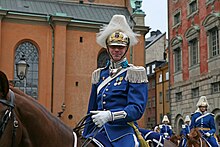Ring collar

The term ring collar is derived from the so-called cervical collar , a crescent-shaped metal shield, which should "protect" the neck (in the sense of "protect") and was placed between armor and helmet .
development
In the 16th and 17th centuries, the neck collar was usually put on without armor and was a service badge for officers in all European armies. The shape shrank more and more to a small, crescent-shaped breastplate worn on a chain . At this point he lost his protective function.
In Germany, the ring collar was worn by Bavarian officers until 1867. Individual cuirassier regiments wore it as a traditional badge. From 1898 the ring collar for flag bearers was introduced.

The ring collar was used as a service badge for the military police in the wars of 1864, 1866 and 1870/71. But even in the Spanish campaign of the English army dragoons deployed as military police wore this field badge in their function.

In the First World War , higher German command authorities were given a variant of the mobilization for a division of soldiers in the staff guard for the guard and orderly service. This was divided into a cavalry and infantry staff guard. A - different - ring collar was worn as a service badge to the normal uniform of officers and men. This, however, in a higher form than the model used by the military police or the standard-bearers. In popular parlance , the Feldgendarmen were referred to as chain dogs , alluding to the metal plaque made of brass with the inscription Feldgendarmerie or Feldjägerkommando , which was carried around the neck on a massive chain.
After the end of the Second World War in 1945 , the ring collar was not reintroduced with the establishment of the Bundeswehr in 1955 in the FRG and with the establishment of the Austrian Armed Forces in 1955 and later in the GDR after the establishment of the National People's Army (NVA) in 1956 - and thus with all German armies .
In the northern European countries, the tradition of the neck collar seems to endure as a protective function . The ring collar that grips the upper chest has been used as an award in Norway , Sweden and Finland to date. In Sweden, the ring collar, officially: Dagbricka m / 1799 in the land forces and the navy, Dagtjänsttecken m / 38 in the air forces, is used as a service badge by the officer in charge and his deputy in the main guard duty as well as from the first and second standard bearer and the chief of an honor guard to all Uniforms (with the exception of the flight outfit and the trade fair suit) are worn. In the Navy, the Vaktmärke m / 54 in gold or silver is worn in the security service and the training departments, depending on the order of the commander.
literature
- Jürgen Kraus: The field-gray uniform of the German army 1907–1918. 2 volumes. Biblio-Verlag, Osnabrück 1999, ISBN 3-7648-2533-2 .
